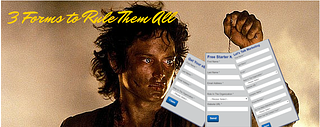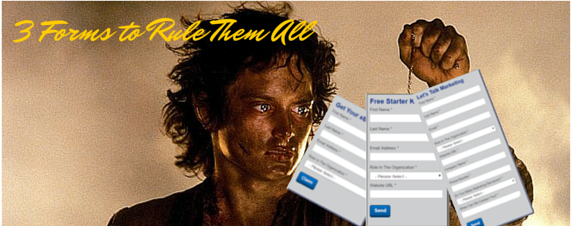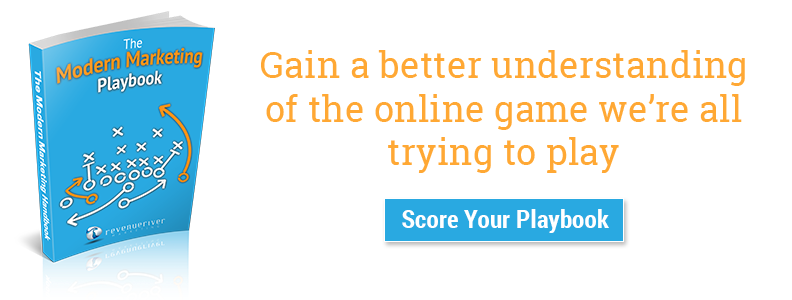5 Reasons You Should Implement the 3 Form System For Your Website


Depending on the size of your website and number of premium content offers, you may have quite a few different forms cluttering up your marketing automation system. I would know, it’s how we used to do things around here. Every time a new offer was created, it received its own new form titled after it. Every bottom of the funnel conversion page received its own form and every webinar collecting the same information had its own form. All together, we had more than 100 used and unused forms!
When implementing a new automated workflow system for our leads we knew that enough was enough when it came to this mess of a system so we began looking for something better. In the end, we decided to stick with the simplest solution; the 3 form system.
What is the 3 form system?
The 3 form system is an extremely simplistic solution for websites where there are only 3 main forms (TOFU, MOFU & BOFU) used throughout the majority of the site. Each form corresponds with the type of offer it will be connected to and the stage in the buyer’s journey the offer is associated with. For example, a simple ebook explaining what social media is and how it can be used by businesses is considered an awareness level piece and thus will utilize a TOFU form.
The idea behind this system is that most offers within the same stage in the buyer’s journey are going to be asking for the same information anyways, so why replicate these questions in separate forms when you can utilize one form for one stage?
While I like to personally call this the 3 form system, it does often require a few extra forms outside of the TOFU, MOFU and BOFU mainstays. Even though these forms will cover a large number of your needs, there are still a few exceptions in which you may need a custom form. For instance, forms on contact pages often times require specific form fields to collect things like ‘best time to contact you’ and notes/comments sections. Going off the main 3 forms is fine in this instance and while you may have to add a few other forms to your collection, the idea still remains that you will drastically reduce the amount of data storage necessary to house all of your forms.
So what else makes this 3 form system so much better than anything else you might be doing? Here are just a few of the biggest benefits you can see from form consolidation.
It cleans up an unorganized mess of different forms
As touched on earlier in this article, having 100+ forms is not exactly ideal inside a marketing automation system. Whittling this number down to less than 10 forms helps to reduce storage space, streamline the decision process and minimize the chance of errors being made with form selection. Doesn’t that sound nice?
It standardizes what you collect from your visitors
We all know that you want to collect different information from visitors depending on what content they are downloading and what stage in the buyer’s journey they seem to be at. The 3 form system allows you to map out exactly what information you would like to be able to collect from someone as they move through the funnel and toward a conversation with your sales team. Make sure that you know the basics of every TOFU lead you generate, you learn about their business as they begin to consider you as a viable option and you know if they are qualified and ready to buy once they sign up to talk to a sales representative.
It helps collect more information from your visitors, faster
Knowing what to ask someone is great. Knowing when to ask them is even better. But what happens if a person spends more time in the awareness stage of the buyer’s journey than you planned and continues to download TOFU offers? This is where a simplified 3 form system and progressive profiling become such a powerful team. While progressive profiling (the ability to ask returning leads new questions on forms they’ve already seen) can be used in the old system of 100 forms, it becomes extremely time-consuming and confusing to keep track of. Having 3 main forms used across the site allows you to quickly enter in additional questions that can help to qualify awareness stage leads faster without requiring a MOFU form submission.
It makes it easier to connect a form submission with the buyer’s journey stage
In our old 100 form system, it took prior knowledge to understand where a lead was at in the buyer’s journey when filling out an offer-specific form. Now, with the new system that connects the form to the buyer’s journey, all it takes is being able to see what form was filled out and on what page to quickly find out if the lead is just browsing or is taking a serious look at your business.
It makes it easier to connect leads in different buyer’s journey stages with persona and stage-specific content
As stated at the beginning of this article, Revenue River’s change to the new 3 form system was spurred on by the creation of a new workflow system that connected the lead’s persona and buyer’s journey stage. In order to make our lives a hell of a lot easier, we implemented the 3 form system because it allowed us to easily track when a person moved from downloading awareness stage offers to consideration and decision. Not only did this make it easier to create lists that tracked and triggered our workflows, but it also allowed us to easily generate goal lists to help our automation move leads to different stage-specific workflows as they showed more interest.
When faced with a simple and a complex option within marketing automation, the simplest route is almost always better – for both the results produced and the sanity of the user involved in its implementation. I can’t tell you how much easier life is with the new 3 form system compared to life before it.
Interested in learning more about the system and how it can integrate with your campaign? Leave your questions in the comments below or shoot me a quick email.
